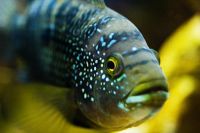Jack Dempsey (Rocio octofasciatum)
From The Aquarium Wiki
(Redirected from Jack Dempsey)
Jack Dempsey
Rocio octofasciatum
208 Litres (55 US G.)
20.3-30.5cm (8-12 ")
Freshwater
7.0 - 8.0
22 -30 °C (71.6-86°F)
9-20 °d
1:1 M:F
8-12 years
Family
Cichlidae
This animal is available captive bred
Contents
Additional names
- Jack Dempsey, Electric Blue Jack Dempsey, The Jack Dempsey
Additional scientific names
- Archocentrus octofasciatus, Nandopsis octofasciatum, Cichlasoma octofasciata, Rocio octofasciata
Origin[edit]
- North and Central America: Atlantic slope from southern Mexico (Papaloapán River) to Honduras (Ulua River).
Sexing[edit]
- Females are paler in colour to the more vivid males. Females fins are rounded whereas males are long and pointed, see identification below. The spangling on the face of a male will cover the top half of the fish's face. The body of the male will have much brighter, more prominent spangles. Females, however, may have some faint spangling on the body but it will be very faded. The female's face may have some spangling but the biggest difference is the bottom portion of the female's face will have blue colouration on the lower portion of the face.
Breeding[edit]
- Once a pair has formed, Jack Dempseys can be exceptionally prolific parents. They will dig a pit in the substrate in which eggs will be laid, and the pair will guard the eggs and fry ferociously until they are ready to be moved on. Spawn sizes can number into the hundreds. Once a pair has bred once they will continue to do so on a regular basis.
Tank compatibility[edit]
- An aggressive fish that does not play well with others. Best kept in a species tank. Although in some instances they can be housed with robust fish such as larger Barbs or Oscars but this will depend entirely on the individual fish's temperament.
Diet[edit]
- A carnivorous fish that will take high-quality Cichlid pellets, bloodworm, brine shrimp, ghost shrimp, crickets, earthworms and other live or frozen foods. May benefit from occasional blanched vegetables in its diet.
Feeding regime[edit]
- Feed once or twice a day.
Environment specifics[edit]
- Prefers a slow current with soft substrate. Hiding places are a must and they will dig, so artificial plants over live would suit them better, or plants that are rooted to decor may work such as Java Fern. They will thrive best with immaculate water quality, so good filtration and frequent water changes are a must, they are, however, tolerant of water temperature and will even cope with water in the sixties (Fahrenheit).
Behaviour[edit]
- An aggressive fish intolerant of others. Likes to dig in the substrate and will dig vigorously during spawning.
Identification[edit]
- A slightly elongated fish with lateral compression, the males' dorsal and anal fins are exceptionally pointed and can be long enough to reach to the middle of the caudal fin. The males can also exhibit a nuchal hump when mature. The females are shorter and more rounded. The caudal fin is fan-shaped. They are attractively coloured, often deep green-blue in base colour and covered with lighter coloured spots or flecks. Vertical bands are visible down the flanks.
Species Variation - Blue Jack Dempsey[edit]
- The Blue Jack Dempsey (BJD), or Electric Blue Jack Dempsey, is now being seen more often in the pet trade. It is not a separate species (although initially given the name Rocio octofasciata), but a colour variation. It is vivid pale blue with mottled black markings. For more details on this fish, read the Practical Fishkeeping Article.
Pictures[edit]
Videos[edit]
External links[edit]
- Fishbase (Mirrors:
 )
)
- Wikipedia
- Badmans Tropical Fish
- Fish Lore
- Tropical Fish Finder - About Electric Blue Jack Dempseys
- Connect Fish Friends



